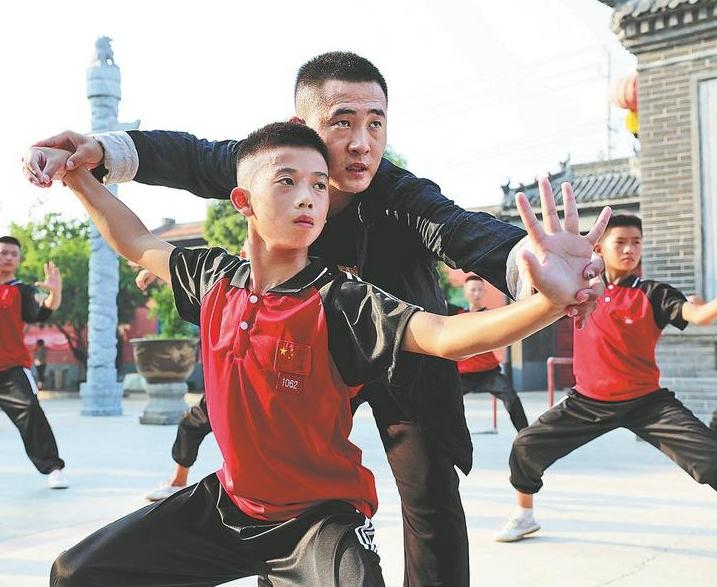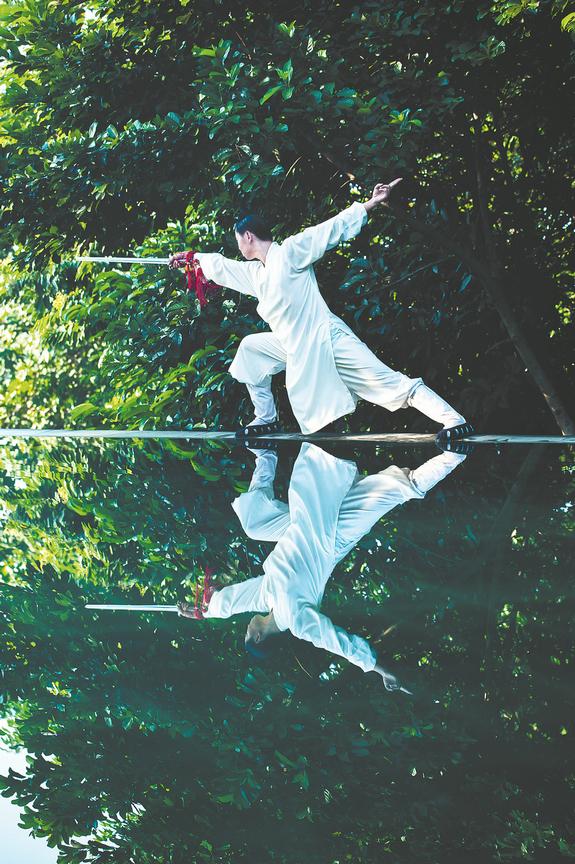Fitting ancient wisdom into a modern lifestyle
 0 Comment(s)
0 Comment(s) Print
Print E-mail China Daily, February 28, 2023
E-mail China Daily, February 28, 2023
Practicing with a sword is a popular exercise among taijiquan enthusiasts.[Photo provided to China Daily]
"I need to be aware of exactly where my strength comes from, whether my body is upright or my stance is correct every second," Song explains, adding that the harmony of body and mind can help reduce anxiety and pain. "Taijiquan is a kind of meditation."
Song used to think taijiquan looked quite gentle but she soon realized that the practice contains infinite power and Chinese wisdom.
"The balance of yin and yang is reflected in each movement," she says.
After practicing taijiquan, Song feels that her skin and her energy levels have become better, as well as her circulation.
When exercising in the gym, Song worked out as hard as possible, to the point of exhaustion, so that she was burning calories all the time.
Practicing taijiquan has instilled in her a completely different outlook that she should save more energy in daily life.
"Saving energy enables me to finish more things," Song explains.
Song learns taijiquan from Li Guangjin, a master who creates his own Li-style taijiquan.
Li, 57, has been practicing martial arts since he was 7 years old. He started to learn taijiquan in his 30s.
After practicing various taijiquan styles including Chen-style, Yang-style and Wu-style, together with his experience of Chinese martial arts and knowledge of health preservation, Li created his own style of taijiquan, which focuses on maintaining health and combat.
Li says taijiquan is a reflection of traditional Chinese philosophy, including Taoist thoughts.
"One key of taijiquan is to keep upright all the time, which is not to stand still but put your center of gravity on your feet."
According to Li, another key of taijiquan is to relax, and practicing taijiquan can reduce stress, which is a major issue in modern society. He says that the slow fluid movements of taijiquan are suitable for people of all ages and fitness levels, and regular practice can improve overall health and well-being, but it has to be done under professional guidance
Li has taught over 10,000 students of different ages and now he has two apprentices who study with him full time. "They are both young university graduates and devoted to learning and inheriting taijiquan," he says.
It's not just Li's prentices. More young people, like Lin Xiaoxue, are breaking the stereotype that taijiquan is "only for the elderly".
A short video she made shows her practicing taijiquan in the morning in traditional garb, before getting dressed up in stylish modern clothes. She posts such videos on Xiaohongshu, and has attracted over 138,000 fans.
The 32-year-old started to practice taijiquan in 2015, to improve her weak constitution. Lin often fell ill as a child and failed to treat her ailments with traditional Chinese and Western medicine. So she decided to take less strenuous exercises and tried to learn taijiquan on her own by watching instructional videos online.
She lived in Vietnam for half a year in 2016, and when she did taijiquan at a temple there, she realized taijiquan's global popularity — she saw a Vietnamese instructor teaching a group of expats the Chinese martial art.
When she came back to China to work in Shenzhen, Guangdong province, as a visual designer, she encountered a group of people practicing taijiquan in a local square.
That's how she got to know her instructor Huang Houda, an apprentice of Tashi, one of the successors of Yang-style taijiquan.
She keeps the habit of practicing taijiquan almost every day at 6 am. After that, she returns home for a shower and goes to work. She also does taijiquan with her master after work.
"It needs great willpower to persist with such regular practice," she says.
"It brings many health benefits. I've built muscle and have a low body fat percentage. When I do taijiquan, I'm in a meditation state, and it eases my anxiety and improves my temperament."
Lin often reads books about it and has gradually become more familiar with the traditional Chinese philosophy of taijiquan. She has also designed some visual works inspired by taijiquan, and hopes to promote the martial art through modern means.
According to Chinese philosophy, tai chi (short for taijiquan) is the ultimate origin of the cosmos. It has also inspired ChiRunning — a combination of tai chi and running, which is purported to reduce injury risk. The training philosophy, founded by ultra-marathon runner Danny Dreyer from the United States, has gained popularity globally. It emphasizes a leaning posture, muscle relaxation, mindfulness and a systematic breathing method.
In 2017, Wen Yi, 52, an avid runner from Huizhou, Guangdong province, went to Shenzhen and Hong Kong for a ChiRunning training event that was taught by Dreyer.
Wen had aches in his knees and fainted once during a marathon, so he decided to find a safer and more efficient running method.
"ChiRunning combines the essence of tai chi philosophy and techniques of running. It's a scientific running system that prevents you from being injured," Wen says.
"Tai chi was originally ancient Chinese wisdom that was published in books. There are more people learning about the wisdom through taijiquan, and starting to comprehend the meaning of life," he says.
The Huizhou Plogging Association has been organizing activities combining jogging with picking up litter. Last year, Wen volunteered to teach others plogging, sharing the techniques of ChiRunning while doing so.
"You can take exercise, do a good deed and protect the environment at the same time, via plogging. Many parents bring their children to join the events," he says.
"It's important to keep pace with modern life to promote tai chi, which is like an old towering tree, and ChiRunning is one of its fruits for today's society. I'm proud that I now teach ChiRunning while plogging, which is very meaningful."






Go to Forum >>0 Comment(s)